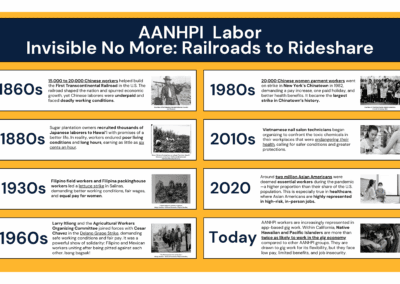As a first-generation Filipina-American, I have often felt invisible in this country–like many of my Asian American, Native Hawaiian, and Pacific Islander (AANHPI) brethren. We experience invisibility in different ways. Some of it stems from the “model minority myth,” and the assumption that we’re all doing well. But, the reality is that many in our communities are struggling–economically, emotionally, and culturally.
Nowhere is our invisibility more consequential than in the workplace. All around us, AANHPI workers are holding up essential industries—in health care, delivery services, and domestic work—yet we remain unseen by the very people we serve. Their labor is vital, but their contributions are often overlooked, undervalued, and erased.
Invisibility has its consequences for us as workers and can lead to economic exploitation. When no one notices us at work–as domestic workers, nail salon techs, or delivery drivers–then no one will protect us from wage theft, poor working conditions, and lack of benefits. Exploitation thrives when no one is watching.
When the dominant image of AANHPI workers is doctors or nurses, then the Filipina domestic workers who provide child care, elder care, or cleaning services are erased, and opportunities for cross-sector and cross-racial alliances are constrained. Visibility comes with the power to demand change. Invisibility enables divide and conquer strategies that uphold racism and classism.
Even our data disappears us. When unemployment data or health statistics lump all AANHPI populations under one category, the strengths and needs of specific communities are masked. During the pandemic, Pacific Islanders suffered some of the highest COVID-19 infection and death rates, and Southeast Asians faced disproportionate job losses—yet few noticed, and fewer responded. What gets counted gets attention. Without visibility, there’s no investment.
For AANHPI Heritage Month, I want to make our labor visible—to connect our past to our present and push back against invisibility as a strategic tool for exploitation. We created a timeline of AANHPI labor—from building railroads in the 1880s to driving rideshares today—so that our stories, our struggles, and our contributions will be invisible no more.

